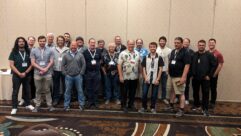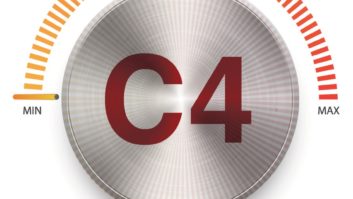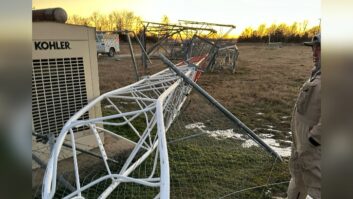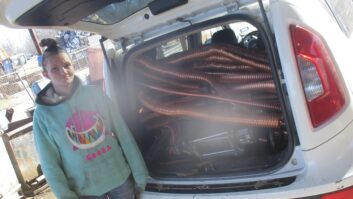Subotech Lead Engineer Sim Mangga shares these tower photos with Workbench readers.
While traveling to another site, Sim was alerted to this failure and snapped some pix. Typically, microwave link towers like these are only 100 to 150 feet high. This site wasn’t even a month old.
Winds apparently were to blame; we can’t know whether poor rigging or materials contributed as well. Sim says a witness reported hearing odd sounds or vibrations when the wind blew, even before the installation had been completed.

Figs. 1–4: The remains of this tower were scattered by high winds. In the fourth photo, we can see where bolts securing the angle iron ripped through the steel.
Certainly, though, these pictures remind us again that, when planning a tower, we should be conservative when estimating conditions the structure may endure; and we should use the best available materials and crews. We don’t want to be asking ourselves after the fact whether this could have been avoided.
I’m always amazed at the physical forces such disasters bring. Look closely at the misshapen holes, where bolts ripped right through the steel.
* * *
Jon Bennett, retired market engineer for Cox in Richmond, Va., writes that there has been another rash of copper theft in his area; he asks Workbench readers for their suggestions.
The police told Jon there have been break-ins at power company sub stations as well as broadcasting facilities. Several office complexes have had outside air conditioners stolen, as many as 10. The problem is not just a broadcaster’s issue.
Workbench and RW have published several articles that discuss this problem in recent years (type “copper theft” into the search box at radioworld.com). I can offer a few ideas here and hope you will add to the list.
For broadcast applications, the first action item is a group effort involving your local SBE chapter.
Go through the phone book or search the Web for junkyards and scrap metal yards that are likely to buy copper strap or coax in your area. Meet with management and explain the severity of this crime. In fact, a motorcade of station vehicles showing up makes a point.
I heard that one chapter assembled 1-by-3-foot boards on which it mounted samples of contraband cable, copper, radial wire, etc. They added a notice that the FBI should be contacted if any of this material were to show up.
The chapter then gave one board to each scrap metal company, asking management to post it prominently.
Don’t forget to include some station T-shirts as a thank you for their cooperation. Getting scrap yards on your side is a good first step.
I’ve got mixed feelings on publicizing the awareness program. Some feel it may encourage more vandalism; the call is yours. However, you may deter someone by pointing out the imprisonment and shock/death hazards.
Next, find out what others are doing to prevent the problem in your market.
Security cameras, fencing and alarm systems can all discourage theft. One engineer told me he added a large sign at the entry driveway, threatening fines and imprisonment and stating that any theft or vandalism to a broadcast facility is a federal offense. He feels this step has made would-be thieves think twice before entering his facility.
Several companies provide a Cat-5 or fiber-optic alarm cable, to be looped through fencing, ground strap and ground plates. When broken, it triggers an alarm. This proactive solution is expensive; lower insurance premiums may offset the cost.
Thanks, Jon, for reminding us that this is an ongoing issue.
E-mail further suggestions to [email protected], or fax them to (603) 472-4944.
* * *
Contract Engineer Ron Gnadinger just had a visit from the FCC to one of the five radio stations he handles on the Michigan peninsula.
The inspector drove 600 miles to check out a complaint that the LP1 wasn’t sending monthly EAS messages. Ron showed the inspector all posted licenses and the auto-logging for the transmitter and EAS.
The inspection resulted in one ding: The station log did not prove that the chief operator had checked the EAS gear or indicated it was functional.
How would you have handled the interaction with the inspector? How could this violation have been avoided?

Fig. 5: Replace constricted flexible duct to improve transmitter exhaust. Ron has been a busy guy. Last December, we showed a picture of a transmitter being exhausted into a crimped flexible duct. The “snorkel” not only constricted the exhaust air, but it was just hanging over the PA exhaust vs. actually being attached to the transmitter (you can see it here).
Fig. 5 here shows the work Ron did when he was called in to relieve the transmitter PA exhaust back pressure and provide a less restricted exhaust path, resulting in better cooling.
Ron writes that he drools over some of the larger-market sites, but reminds readers that even on a limited budget, realistic solutions are available.
John Bisset marked his 40th year in radio in broadcasting recently. He works for Tieline Technology. He is a past recipient of the SBE’s Educator of the Year Award. Reach him at[email protected]. He can be reached at (603) 472-5282. Faxed submissions can be sent to (603) 472-4944.
Submissions for this column are encouraged and qualify for SBE recertification credit.












